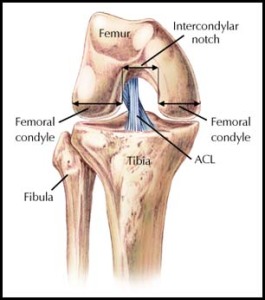Anterior cruciate ligament rupture
Our knees play a major part to us and one should never ignore knee pain.
Injury to the anterior cruciate ligament (ACL) can occur in any physical activity that requires twisting, changes of direction or jumping. The high profile of ACL injury due to its occurrence in elite athletes makes this injury a subject of interest.
The ACL runs up (superiorly) and back (posteriorly) from its attachment on the front of the tibial plateau to its femoral attachment at the back of the intercondylar notch of the femur (thigh bone). The roles of this important ligament are to prevent forward movement of the tibia in relation to the femur, as well as assisting in controlling the rotation of the knee.
The name cruciate refers to the cross, or crucifix, the ACL makes with the posterior cruciate ligament (PCL) inside the knee – these ligaments the ACL and PCL, have also been referred to as the crucial ligaments in recognition of their importance in sporting knee performance.
If you have concerns you have hurt your knee in jumping actions etc and feel pain within your knee, be it swelling, or continual pain even after rest, you will be best to have a Magnetic Response Image (MRI) to define the diagnosis of an ACL rupture.
Some patients may need treatment either surgical (reconstruction) or non-surgical.
Please be aware with how your body feels make sure you have your knee looked at as it’s not worth ignoring as you could damage more ligaments by not addressing the injury.
The LARS system (Ligament Augmentation and Reconstruction System) is proving that it’s removing some of the post operative issues that make the other traditional surgical repair a longer process. The LARS process has been able to have a more aggressive rehabilitation and return to physical activity, but the patient still has to be aware that they need to ease into exercise to ensure the graft of the ligament is not put in too much risk.
The exercises/rehabilitation will be prescribed by a physiotherapist and may include flexion, stretching work, quadricep contractions, use of a band, rolled up towel etc.
Then you will work on building some weighted work into your exercises. But the main focus is working within your limits and abilities and not rushing back into fully loaded exercises.


